
A hotel is an establishment that provides paid lodging on a short-term basis. Facilities provided inside a hotel room may range from a modest-quality mattress in a small room to large suites with bigger, higher-quality beds, a dresser, a refrigerator, and other kitchen facilities, upholstered chairs, a flat-screen television, and en-suite bathrooms. Small, lower-priced hotels may offer only the most basic guest services and facilities. Larger, higher-priced hotels may provide additional guest facilities such as a swimming pool, a business center with computers, printers, and other office equipment, childcare, conference and event facilities, tennis or basketball courts, gymnasium, restaurants, day spa, and social function services. Hotel rooms are usually numbered to allow guests to identify their room. Some boutique, high-end hotels have custom decorated rooms. Some hotels offer meals as part of a room and board arrangement. In Japan, capsule hotels provide a tiny room suitable only for sleeping and shared bathroom facilities.

A motel, also known as a motor hotel, motor inn or motor lodge, is a hotel designed for motorists, usually having each room entered directly from the parking area for motor vehicles rather than through a central lobby. Entering dictionaries after World War II, the word motel, coined as a portmanteau of "motor hotel", originates from the Milestone Mo-Tel of San Luis Obispo, California, which was built in 1925. The term referred to a type of hotel consisting of a single building of connected rooms whose doors faced a parking lot and in some circumstances, a common area or a series of small cabins with common parking. Motels are often individually owned, though motel chains do exist.
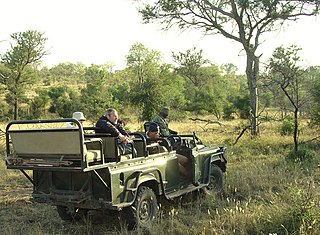
A safari is an overland journey to observe wild animals, especially in Southeast Africa. The so-called "Big Five" game animals of Africa – lion, leopard, rhinoceros, elephant, and Cape buffalo – particularly form an important part of the safari market, both for wildlife viewing and big-game hunting.

Camping is a form of outdoor recreation or outdoor education involving overnight stays with a basic temporary shelter such as a tent. Camping can also include a recreational vehicle, sheltered cabins, a permanent tent, a shelter such as a bivy or tarp, or no shelter at all. Typically, participants leave developed areas to spend time outdoors, in pursuit of activities providing them enjoyment or in a form of educational experience. Spending the night away from home distinguishes camping from day-tripping, picnicking, and other outdoor activities.

A tent is a shelter consisting of sheets of fabric or other material draped over, attached to a frame of poles or a supporting rope. While smaller tents may be free-standing or attached to the ground, large tents are usually anchored using guy ropes tied to stakes or tent pegs. First used as portable homes by nomads, tents are now more often used for recreational camping and as temporary shelters.

The Süleymaniye Mosque is an Ottoman imperial mosque located on the Third Hill of Istanbul, Turkey. The mosque was commissioned by Suleiman the Magnificent and designed by the imperial architect Mimar Sinan. An inscription specifies the foundation date as 1550 and the inauguration date as 1557, although work on the complex probably continued for a few years after this.

Chessington World of Adventures Resort is a 128 acres theme park, zoo and hotel complex in Chessington, Greater London, England, around 12 miles (19 km) southwest of Central London. The complex originally opened as Chessington Zoo in 1931; the theme park aspect was developed by The Tussauds Group, debuting on 7 July 1987 as one of the first combined animal-amusement parks in the UK. The theme park, which features over 40 rides, is now owned by Merlin Entertainments, following its merger with The Tussauds Group in 2007. Under Merlin, Chessington has been increasingly developed into a resort and tourist destination, including two on-site hotels, swimming pools, a campground, spa and fitness facilities.
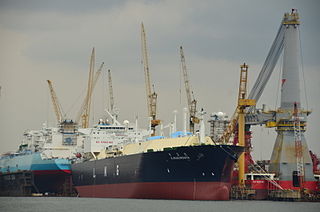
The North Region of Singapore is one of the five regions in the city-state. The region is the second largest region in terms of land area, and has a population of 582,330. Woodlands is the regional centre and also the most populous town with 255,130 residents living in the area. Comprising 13,500 hectares of land area, it includes eight planning areas.
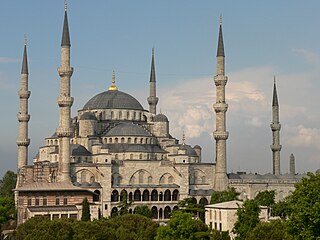
Ottoman architecture is an architectural style or tradition that developed under the Ottoman Empire over a long period, undergoing some significant changes during its history. It first emerged in northwestern Anatolia in the late 13th century and developed from earlier Seljuk Turkish architecture, with influences from Byzantine and Iranian architecture along with other architectural traditions in the Middle East. Early Ottoman architecture experimented with multiple building types over the course of the 13th to 15th centuries, progressively evolving into the classical Ottoman style of the 16th and 17th centuries. This style was a mixture of native Turkish tradition and influences from the Hagia Sophia, resulting in monumental mosque buildings focused around a high central dome with a varying number of semi-domes. The most important architect of the classical period is Mimar Sinan, whose major works include the Şehzade Mosque, Süleymaniye Mosque, and Selimiye Mosque. The second half of the 16th century also saw the apogee of certain decorative arts, most notably in the use of Iznik tiles.

A hut is a small dwelling, which may be constructed of various local materials. Huts are a type of vernacular architecture because they are built of readily available materials such as wood, snow, ice, stone, grass, palm leaves, branches, clay, hides, fabric, or mud using techniques passed down through the generations.

The Eyüp Sultan Mosque is in the Eyüp district of Istanbul, outside the city walls and near the Golden Horn. The mosque complex includes a mausoleum marking the spot where Ebu Eyüp el-Ansari, the standard-bearer and companion of the Islamic prophet Muhammad, is said to have been buried. On a much older site, the present building dates from the beginning of the 19th century.
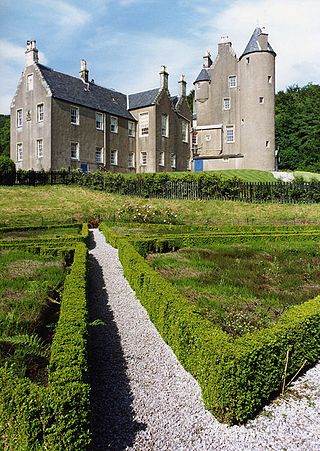
Kelburn Castle is a large house near Fairlie, North Ayrshire, Scotland. It is the seat of the Earl of Glasgow. Originally built in the thirteenth century it was remodelled in the sixteenth century. In 1700, the first Earl made further extensions to the house in a manner, not unlike a French château which is virtually how it appears today. In 1977 the house and grounds opened to the public as a country park. It is one of the oldest castles in Scotland and has been continuously inhabited by the same family for longer than any other. The castle is protected as a category A listed building, while the grounds are included in the Inventory of Gardens and Designed Landscapes in Scotland.
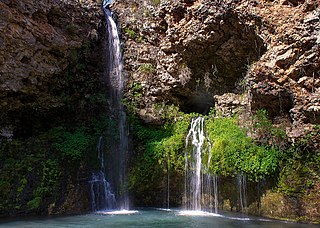
Natural Falls State Park is a 120 acres (0.49 km2) state-owned park in the Ozarks, in Delaware County, Oklahoma. It lies along U.S. Highway 412, near the Arkansas-Oklahoma state line. The property was privately-owned and known as Dripping Springs until 1990, when the state bought it. The previous owners had also used the property as an attraction and rest stop for travelers on the highway, featuring a swimming pool and gardens. The site was used in the production of the 1974 film "Where the Red Fern Grows".

Outdoor dining, also known as al fresco dining or dining al fresco, is the act of eating a meal outside.

Nurhan Atasoy is a Turkish art historian. She specializes in history of Ottoman and Islamic art. She served as a chair in the Department of Fine Arts, Archeology and Art History at Istanbul University until 1999 when she retired. She is a resident scholar of the Turkish Cultural Foundation.

White Desert Ltd. is a British tour operator conducting expeditions to Antarctica. As of 2021, it is the only company to offer a commercial private jet service to the continent. Its Whichaway Camp is described by multiple publications as Antarctica's first and only hotel.

Ottoman Baroque architecture, also known as Turkish Baroque, was a period in Ottoman architecture in the 18th century and early 19th century which was influenced by European Baroque architecture. Preceded by the changes of the Tulip Period and Tulip Period architecture, the style marked a significant departure from the classical style of Ottoman architecture and introduced new decorative forms to mostly traditional Ottoman building types. It emerged in the 1740s during the reign of Mahmud I (1730–1754) and its most important early monument was the Nuruosmaniye Mosque, completed in 1755. Later in the 18th century, new building types were also introduced based on European influences. The last fully Baroque monuments, such as the Nusretiye Mosque, were built by Mahmud II in the early 19th century, but during this period new European-influenced styles were introduced and supplanted the Baroque.

Amangiri is a resort hotel in the Lake Powell region of the U.S. state of Utah. Part of Aman Resorts, it was designed by Marwan Al-Sayed, Rick Joy, and Wendell Burnett, and opened in 2009.
Cherry Hill Park is a campground located in College Park, Maryland. Situated in Prince George's County, the location has served as a destination for locals and tourists since its establishment in the early 20th century. The park has RV & tent sites, log cabins, cottages, yurts, and glamping pods. Amenities include mini golf, fishing, golf cart rentals, a hot tub & sauna, and an on-site cafe.

AutoCamp is a hotel company that allows customers to rent Airstream trailers to glamp near popular recreational areas, such as national parks. Its has six locations in California, Massachusetts, New York, and Utah. AutoCamp Yosemite was listed by Time magazine as one of the "World's Greatest Places" in 2019. AutoCamps are known for their luxury aspect, sometimes costing over $500 per night for a normal trailer. It is in a partnership with the Airstream company itself.

























